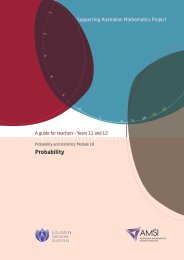Binomial distribution - the Australian Mathematical Sciences Institute
Binomial distribution - the Australian Mathematical Sciences Institute
Binomial distribution - the Australian Mathematical Sciences Institute
You also want an ePaper? Increase the reach of your titles
YUMPU automatically turns print PDFs into web optimized ePapers that Google loves.
A guide for teachers – Years 11 and 12 • {5}<br />
Content<br />
Bernoulli trials<br />
The module Discrete probability <strong>distribution</strong>s discusses <strong>the</strong> idea of a sequence of independent<br />
trials, where each trial has <strong>the</strong> same probability of success p. This structure<br />
leads to a number of random variables with different <strong>distribution</strong>s. In that module, <strong>the</strong><br />
trials structure is used to introduce <strong>the</strong> geometric <strong>distribution</strong>. Because of <strong>the</strong> general<br />
importance of <strong>the</strong> trials structure, we examine it systematically in this module.<br />
The central idea is a Bernoulli trial — named after Jacob Bernoulli (1655–1705), who was<br />
one of a family of prominent ma<strong>the</strong>maticians. A Bernoulli trial is a random procedure<br />
that can have one of two outcomes, which are arbitrarily labelled ‘success’ and ‘failure’.<br />
Example: Tetris<br />
The following random procedure is considered in <strong>the</strong> module Probability.<br />
During a game of Tetris, we observe a sequence of three consecutive pieces. Each Tetris<br />
piece has one of seven possible shapes: I,J,L,O,S,T,Z. So in this random procedure, we<br />
can observe a sequence such as JLL, ZOS, ZSZ, III and so on.<br />
For each sequence of three pieces, we may ask: Does it contain at least one Z The<br />
sequence of three pieces is <strong>the</strong> test or ‘trial’. A sequence of three pieces containing a Z is<br />
regarded as a success, and one without a Z as a failure.<br />
From <strong>the</strong> point of view of this question, it does not matter what <strong>the</strong> o<strong>the</strong>r shapes in a<br />
sequence are. All we are concerned about is whe<strong>the</strong>r or not <strong>the</strong> sequence has a Z.<br />
A Bernoulli trial has a corresponding Bernoulli random variable, which counts <strong>the</strong> number<br />
of successes in a single trial. The only possible values of this random variable are zero<br />
and one; <strong>the</strong> random variable takes <strong>the</strong> value one if a success occurs, and <strong>the</strong> value zero<br />
if a failure occurs.<br />
Let X be a Bernoulli random variable with parameter p, where 0 < p < 1. The probability<br />
function p X (x) of X is given by<br />
⎧<br />
⎨p if x = 1,<br />
p X (x) = Pr(X = x) =<br />
⎩<br />
1 − p if x = 0.

















